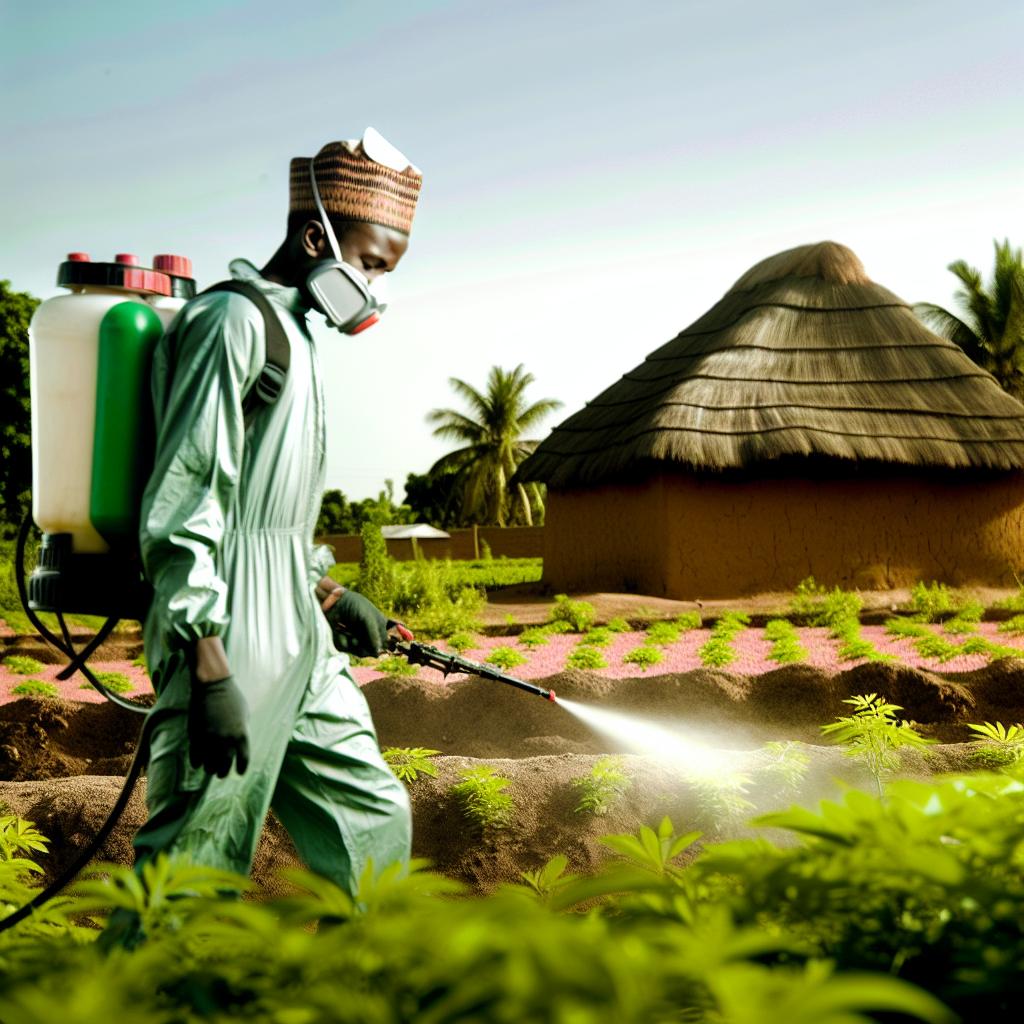Introduction
Pest control is crucial in agriculture to protect crops.
This blog post focuses on pest control technologies in agricultural engineering.
Using advanced tools and methods can help farmers combat pests effectively.
Innovative technologies play a key role in minimizing crop damage.
Agricultural engineering seeks to develop sustainable solutions for pest management.
Integrating technology in pest control ensures higher yields and better quality produce.
Modern techniques like biological control and precision spraying are gaining popularity.
Digital tools enable farmers to monitor pest populations and apply targeted treatments.
Genetic engineering is also being explored to create pest-resistant crop varieties.
Overall, pest control technologies in agricultural engineering are essential for sustainable farming practices.
Farmers have long relied on traditional methods for pest control in agricultural engineering.
These methods include crop rotation, handpicking of pests, and the use of natural predators.
One of the limitations of traditional pest control methods is their time-consuming nature.
Farmers often have to spend hours manually removing pests or implementing crop rotation strategies.
Another drawback is the effectiveness of these methods in large-scale agricultural settings.
Traditional methods may not be sufficient to control pests in vast fields, leading to crop damage.
Additionally, traditional pest control methods can be labor-intensive and require a significant amount of manual labor.
This can be unsustainable for farmers, especially those with large agricultural operations.
With advancements in agricultural engineering, modern pest control technologies have been developed.
These technologies are more efficient, cost-effective, and environmentally friendly.
Some of the modern pest control technologies include the use of insect pheromones.
Pheromones can disrupt the mating behaviors of pests, reducing their population without the use of harmful chemicals.
Another innovative technology is the use of drones for precision agriculture.
Drones equipped with sensors can identify pest-infested areas and deliver targeted treatments, reducing pesticide use.
Genetic modification of crops has also been used as a pest control strategy.
Crops can be engineered to produce toxins that are harmful to pests while being safe for human consumption.
Modern pest control technologies offer several benefits over traditional methods.
These technologies are more precise, resulting in reduced pesticide use and minimized environmental impact.
By targeting specific pest populations, modern technologies help to preserve beneficial insects.
This can lead to a more balanced ecosystem and healthier crops overall.
Additionally, modern pest control technologies can increase crop yields and improve food security.
With more efficient pest control methods, farmers can protect their crops from damage and increase productivity.
The use of modern pest control technologies also promotes sustainable agriculture.
By reducing the reliance on chemical pesticides, these technologies help to protect the environment and promote long-term agricultural viability.
Modern Pest Control Technologies
Introduction of modern technologies that have revolutionized pest control in agriculture.
- Integrated Pest Management (IPM): Incorporates various control methods for sustainable pest management.
- Precision Agriculture: Uses data and technology to apply pesticides only where needed.
- Biological Control: Introduces natural predators or pathogens to manage pest populations.
- Trap Crops: Plants specifically grown to attract pests away from main crops for easy removal.
These modern technologies have significantly improved pest control in agriculture by providing more sustainable and environmentally friendly solutions.
Benefits and Effectiveness:
- Reduced Chemical Usage: IPM and precision agriculture minimize the need for broad-spectrum pesticides.
- Cost-Effective: By targeting specific areas, farmers can reduce overall pesticide expenses.
- Environmental Protection: Biological control methods do not harm beneficial insects or wildlife.
- Improved Crop Health: Trap crops prevent pest damage, leading to healthier plants and higher yields.
The integration of modern pest control technologies in agricultural engineering has proven to be a game-changer for farmers worldwide.
By embracing these innovative solutions, farmers can effectively manage pests while minimizing environmental impact and ensuring sustainable agricultural practices for future generations.
Find Out More: Understanding Land Surveying Regulations in Nigeria
Transform Your Career with Expert Guidance
Get personalized mentorship consulting that’s tailored to your unique path. Our expert advice is actionable and exclusive.
Get StartedIntegrated Pest Management (IPM) Systems:
- Explanation of IPM systems and their approach to pest control.
- Examples of successful implementation of IPM systems in agriculture.
Explanation of IPM systems and their approach to pest control:
Integrated Pest Management (IPM) systems are sustainable, holistic approaches to managing pest populations in agricultural settings.
These systems focus on preventing pest problems from occurring in the first place, rather than relying solely on chemical treatments after pests have already infested a crop.
IPM systems take into account the biology and behavior of pests, as well as environmental factors that may influence their populations.
By using a variety of methods, such as biological controls, cultural practices, and monitoring techniques, IPM systems aim to keep pest populations below damaging levels while minimizing the impact on the environment and human health.
Examples of successful implementation of IPM systems in agriculture:
One notable example of successful IPM implementation is the use of pheromone traps in apple orchards.
By strategically placing traps that emit sex pheromones to disrupt the mating behavior of pests like codling moths, farmers have been able to reduce the need for chemical insecticides while still effectively controlling pest populations.
Another successful case of IPM in action is the practice of rotating crops to break pest cycles.
By alternating crops in a field, farmers can disrupt the life cycles of specific pests that rely on a single host plant.
This technique has been especially effective in organic farming, where synthetic pesticides are not used.
Some vineyards have also implemented IPM strategies by introducing predatory insects, such as ladybugs, to control aphid populations.
These natural enemies help to keep aphid numbers in check, reducing the need for chemical treatments that can harm beneficial insects or contaminate the grapes.
Integrated Pest Management systems offer a more sustainable and environmentally friendly approach to pest control in agriculture.
By utilizing a combination of methods tailored to the specific needs of each crop and pest species, farmers can effectively manage pest populations while reducing their reliance on synthetic chemicals.
The examples provided demonstrate the success that can be achieved through the implementation of IPM strategies in various agricultural contexts.
Find Out More: Challenges Facing Mechatronics Engineers in Nigeria
Biocontrol Techniques:
Description of biocontrol methods used in pest management.
Discussion of the advantages of using biocontrol techniques compared to chemical pesticides.
When it comes to pest control technologies in agricultural engineering, biocontrol techniques play a crucial role in managing pests effectively and sustainably.
Description of Biocontrol Methods:
Biocontrol methods involve the use of natural enemies or organisms to control pest populations. One common biocontrol method is the introduction of predator insects that feed on pest species.
Another biocontrol approach is the use of pathogenic microorganisms such as bacteria, fungi, and viruses that can infect and kill pests without harming the environment.
Furthermore, biocontrol can also include the release of parasitoids, which are organisms that lay eggs inside or on the pest, eventually killing it.
Advantages of Biocontrol Techniques:
- Environmentally Friendly: Biocontrol methods do not leave harmful residues in the environment, making them safe for non-target organisms and ecosystems.
- Target Specificity: Biocontrol agents are often specific to the pest species they target, reducing the risk of harming beneficial insects or other organisms.
- Sustainable Solution: Biocontrol techniques offer a long-term solution to pest management as natural enemies can establish populations and control pest outbreaks over time.
- Reduced Resistance: Unlike chemical pesticides, pests are less likely to develop resistance to biocontrol agents, making them more effective in the long run.
Biocontrol techniques offer a sustainable and effective solution to pest management in agriculture. By harnessing the power of natural enemies and organisms, farmers can reduce their reliance on chemical pesticides and promote a healthy and balanced ecosystem.
Learn More: Biomedical Engineering Workshops and Training in Nigeria
Precision Agriculture Applications:
Precision agriculture revolutionizes pest control techniques in the farming industry.
Drones equipped with advanced sensors are used to detect pests in large agricultural fields.
These drones can provide real-time data on pest infestations, allowing farmers to take immediate action.
By accurately pinpointing areas with pest problems, farmers can apply targeted treatments, reducing chemical usage.
Sensors placed strategically in fields can monitor pest activity and alert farmers when intervention is needed.
This proactive approach helps farmers prevent pest outbreaks before they cause significant damage to crops.
Precision agriculture technologies enable farmers to create detailed maps of pest infestations for efficient management.
Automated systems can dispense pest control products precisely, minimizing waste and environmental impact.
The use of precision agriculture in pest control promotes sustainable farming practices and ensures higher crop yields.
Overall, the integration of drones and sensors in pest management enhances efficiency and productivity in agriculture.
Explore Further: Land Surveying and Geoinformatics: A Career Overview

Genetic Engineering in Pest Control:
Genetic engineering techniques are utilized to develop pest-resistant crops.
Using genetically modified organisms (GMOs) raises ethical concerns and provides benefits in pest control.
Genetic engineering plays a crucial role in modern agricultural practices.
By manipulating the genetic makeup of crops, scientists are able to create varieties that are resistant to pests.
This has revolutionized pest control in agriculture, offering a sustainable and effective solution to combat crop damage caused by insects.
One of the primary techniques used in genetic engineering for pest control is the introduction of genes from other organisms that have natural pest resistance.
This transfer of genes allows the crop to produce proteins that are toxic to specific pests, effectively deterring them from feeding on the plant.
Despite the benefits of using genetically modified organisms (GMOs) in pest control, there are ethical concerns surrounding their widespread adoption.
Critics argue that GMOs pose long-term environmental risks and could potentially harm beneficial insects or ecosystems.
The use of GMOs also raises questions about food safety and human health implications.
On the other hand, proponents of genetic engineering in pest control highlight the significant advantages it offers in terms of reducing pesticide usage.
By creating crops that are naturally resistant to pests, farmers can minimize their reliance on chemical pesticides, thereby reducing the harmful impact on the environment and human health.
Furthermore, genetically engineered crops have the potential to increase crop yields and improve agricultural productivity.
By protecting crops from pest damage, farmers can expect higher yields and better quality produce.
This is particularly important in ensuring food security and meeting the growing global demand for food.
Genetic engineering in pest control presents both challenges and opportunities for the agricultural sector.
While there are ethical concerns to address, the benefits of using GMOs in creating pest-resistant crops cannot be ignored.
With careful regulation and monitoring, genetic engineering can play a vital role in sustainable pest management practices in agriculture.
Data-Driven Pest Control Strategies:
In today’s world of agriculture, the use of data-driven pest control strategies has become increasingly prevalent.
By harnessing the power of data analytics and machine learning, farmers and agricultural engineers can make more informed decisions when it comes to managing pests on their crops.
Let’s explore how these technologies are being utilized in the field of pest control.
Utilizing Data Analytics:
Data analytics involves the analysis of large sets of data to identify patterns and make predictions.
In the realm of pest control, data analytics can be used to monitor pest populations, track their movements, and even predict potential outbreaks.
By collecting data on factors such as weather patterns, soil conditions, and pest behavior, farmers can gain valuable insights into the best ways to combat pests effectively.
Application of Machine Learning:
Machine learning takes data analytics a step further by using algorithms to analyze data, learn from it, and make predictions without being explicitly programmed.
In the context of pest control, machine learning can be used to develop predictive models that can anticipate pest movements and identify the most effective control measures.
By continuously learning from new data, these models can adapt and improve over time, making them invaluable tools for pest management.
Examples of Data-Driven Strategies:
One example of a data-driven pest control strategy is the use of pheromone traps, which are equipped with sensors that can collect data on pest populations in real-time.
By analyzing this data, farmers can determine the optimal timing for pest control interventions, maximizing their effectiveness.
Additionally, the use of drones equipped with infrared cameras and machine learning algorithms can help identify areas of infestation quickly and accurately, allowing for targeted control measures to be implemented.
Benefits of Data-Driven Pest Control:
There are several benefits to adopting data-driven pest control strategies.
By leveraging data analytics and machine learning, farmers can reduce the use of chemical pesticides, minimizing potential harm to the environment and human health.
Additionally, data-driven strategies can lead to higher crop yields, as pests are managed more efficiently and effectively.
Ultimately, by harnessing the power of data, farmers can achieve sustainable pest control practices that benefit both their crops and the ecosystem as a whole.
Implications of Pest Control Technologies in Agriculture
Pest control technologies in agricultural engineering play a vital role in ensuring sustainable agriculture.
Integrated pest management, precision agriculture, and biological controls are some approaches used to minimize chemical pesticide use.
These innovative practices promote environmental stewardship.
By combining traditional methods with modern technologies, farmers can effectively manage pest populations.
This approach reduces negative environmental impacts.
Investing in research and development is essential to enhance these technologies.
Making them more accessible to farmers is equally important.
Summary of Key Points
- Integrated pest management and precision agriculture are essential for sustainable pest control.
- Biological controls offer a natural and environmentally friendly alternative to chemical pesticides.
- Modern pest control technologies help reduce chemical pesticide use and minimize environmental impact.
- Investing in research and development is crucial to enhance pest control technologies.
Encouragement for Farmers and Engineers
Farmers and agricultural engineers must embrace modern pest control technologies.
Innovation ensures sustainable agriculture.
We can protect crops, the environment, and future generations.
Let’s work together to positively impact food production systems.
Promoting a healthier planet benefits us all.
Additional Resources
Interventions to Reduce Pesticide Exposure from the Agricultural …
Enhancing smart farming through the applications of Agriculture 4.0 …




